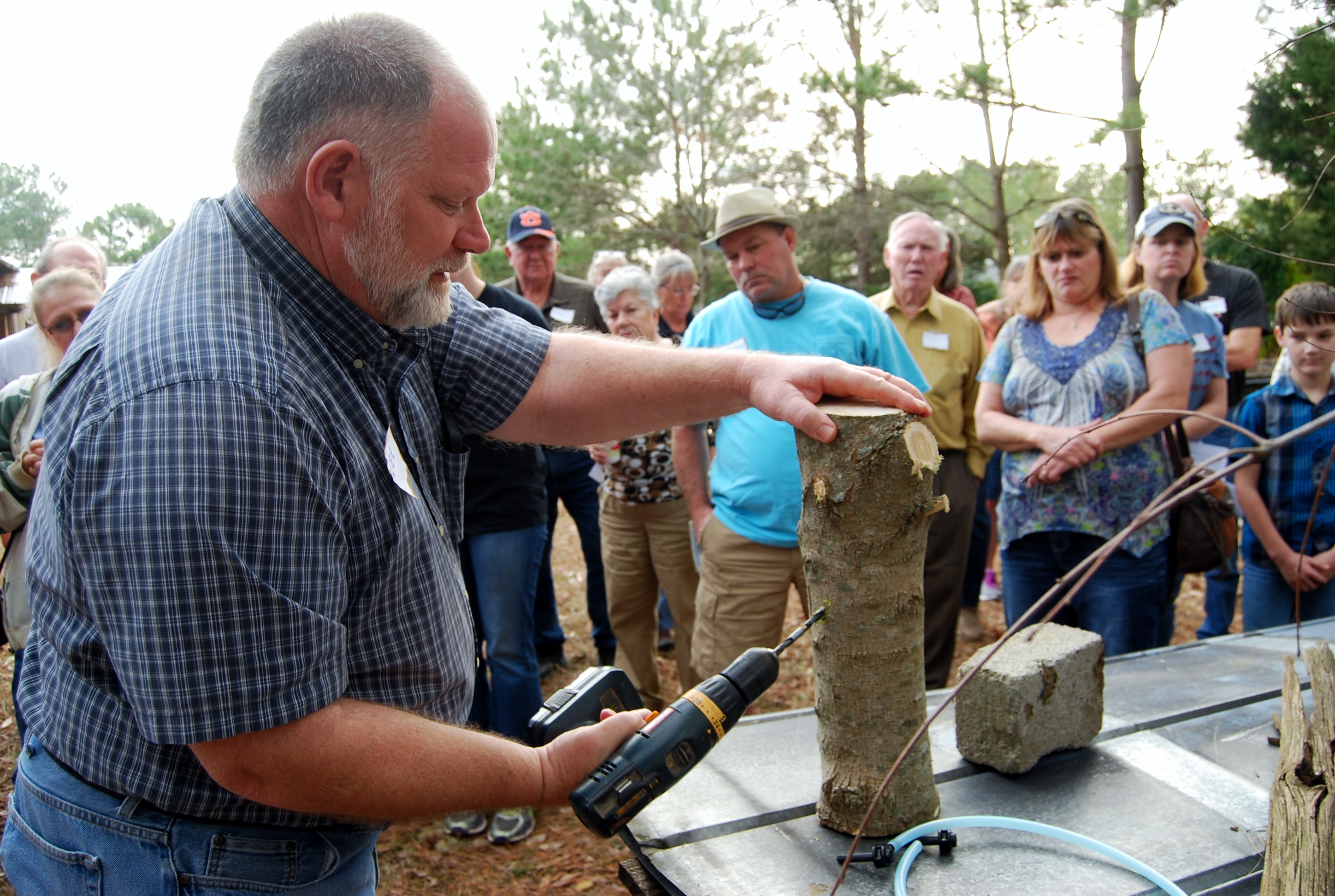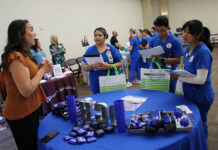Lee McBride demonstrates how to tap a tree for its sugary sap, which is excellent for making syrup. Before modern methods made tapping trees almost obsolete for individual families, this is how most households acquired maple syrup.
CULLMAN – The house was packed Sunday afternoon for the first meeting of the new Peinhardt Homesteaders group, held at the Peinhardt Farm Museum. The first month’s subject: tapping trees for making syrup.
Almost a dying craft, tapping trees is a slow and tedious process, and for those who didn’t have a lot of time on their hands, it became quicker to run to the supermarket and pick up a bottle of Log Cabin or Mrs. Butterworth’s rather than take the time to make syrup at home.
However, with the renaissance of the old ways of doing things, from making your own butter to spinning wool for thread, people are reviving these nearly lost arts so that future generations will know how people lived in the days before the Industrial Revolution made such goods available to people who quickly forgot how to fend for themselves in these once common everyday jobs and household tasks.
The purpose of the Homesteaders, whose motto is “Reconnect and Reskill," is to teach and demonstrate things like tapping trees, and other useful arts that are done by hand, and the sweat of one’s brow.
The location was perfect for such an interesting afternoon class. Peinhardt Farm, located on Talley Ho Street, has amassed an incredible collection of tools, bottles, washtubs and boiling pots, and machinery of all kinds, housed in one location. The intent is obvious; this place brings the past into sharp focus, with not one computer, iPad, cell phone, pager, television or radio in the entire collection!
The goods, equipment and machines on display here were once operated by men and women who toiled to make their way in the world knowing that they wouldn’t eat in the winter if they didn’t work hard in the spring, summer and fall.
“Humans have been processing sugar for thousands of years,” said spokesperson, Shannon McBride. “Although older recipes don’t call for sugar as much as they did for spices,” she pointed out.
According to McBride, it was more commonplace for people in the South to acquire their sugar from sugarcane plants, unlike their Northern counterparts who harvested sap from trees in large quantities every year.
“Sugar was a luxury,” she added.
McBride paused in her presentation to remind the group of the importance of gleaning information about the old ways of doing things from elderly relatives and neighbors before they lose those valuable resources.
Resuming her dialog, she went on to say that sap has all of the nutrients that a tree needs to survive and thrive. “That being said, it must be good for humans, too,” she said.
One of the most important points made during the class was when to tap a tree to achieve the greatest yield. “Once the tree breaks bud the chemistry changes and the sap isn’t good for syrup after that,” she stressed.
The information McBride presented also included such facts as the following:
Tree sap is high in fructose; therefore, it is easier for a diabetic to digest.
Huge amounts of vitamins can be found in tree sap, including large amounts of Vitamin C.
Sycamore trees produce a sap that bears a strong resemblance to butterscotch.
Sap ferments quickly, so it is best to process it immediately because it attracts ants.
McBride’s husband, Lee McBride, demonstrated his method of inserting the tap into the tree as the class adjourned to a location just outside the building. Everyone present received a plastic tap. He started the class by mentioning the importance of cleaning all elements of the equipment used to tap the tree, “The single most important thing about this process is keeping that drill bit clean,” he said solemnly.
Everything used should be sterilized. Sterilize bottles and caps in boiling water.
He went on to inform the students that the ideal height for the tap is about 3 feet from the ground, and just above a big root. “Do not tap within 6 inches of a former tap hole,” he emphasized.
“Sap flows best when day temps rise above freezing and night temps fall below freezing,” said McBride. “You get more sap from that ‘push-pull’ of the temps,” agreed both McBrides.
Lee McBride advised students not to tap a specimen tree near their curb, indicating that in some cases, if conditions are not just right, tapping can actually harm or even kill a tree.
The Peinhardt Homesteaders will meet monthly with different topics of interest each month. Connect with the group on Facebook for details at http://qrne.ws/homesteaders.
For more information on tapping trees, contact your local Extension office.
You can find a wealth of information at TapMyTrees.com
www.maplemadness.com
www.smokylakepaole.com
www.motherearthnews.com /real-food/how-to-make-maple-syrup-at-home
www.adirondackalmanack.com
More
The following trees suitable for tapping grow in our zone.
- Sugar Maple, which yields the highest volume and concentration of sap
- Black Maple
- Red Maple
- Silver Maple
- Norway Maple
- Boxelder
- Black Walnut
- Paper Birch
- Black Birch
- River Birch
- Sycamore
- Ironwood
Copyright 2017 Humble Roots, LLC. All Rights Reserved.


























